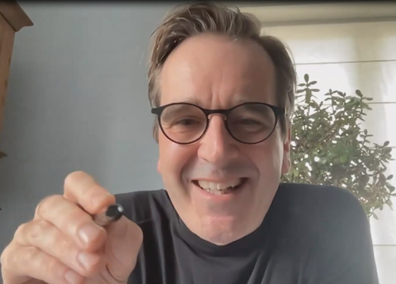I’m sitting together with two widely known experts in dermatology, especially in prurigo, Prof. Sonja Ständer from Münster University Hospital in Germany and Ass. Prof. Jesper Elberling from Herlev and Gentofte Hospital, Copenhagen, in Denmark. They regularly work together in specialist groups discussing chronic prurigo and prurigo nodularis, but today they have promised to discuss this disease with me from its beginning: what is the natural history of chronic prurigo and where does it emerge from? Why do some patients get this chronic disease and others not? And what does this complex condition mean for patients?

Prof. Sonja Ständer

Prof. Jesper Elberling
Would you prefer to listen to the article?
Click on the headphones!
Time: 12.01
To read the article
Click on the chapters below
- Hyde JN (1909) A practical treatise on diseases of the skin, for the use of students and practioners, 8. Aufl. Lea Brothers, Philadelphia, S 174–175
- Pereira et al. JEADV 2018 32, 1059-1065
- Pereira et al. Eur Acad Dermatol Venereol. 2019 Feb;33(2):263-266
- Sutaria et al. J Invest Dermatol 2022 142(9):2537-2540
- Tsoi et al. J Allergy Clin Immunol 2022;149:1329-39
- Pogatzki-Zah et al. J Invest Dermatol. 2020 Jan;140(1):203-211
- Williams et al. J Am Acad Dermatol. 2020 Dec;83(6):1567-1575
- Agelopoulos et al. J Invest Dermatol 2023 Feb;143(2):264-272
- Feng et al. Science 2018;360(6388): 530-533
- Nahass. J Am Acad Dermatol. 1994 Jul;31(1):86-8
This very pruritic disease has been known for a long time — it was first observed in 1879 and described for the scientific community in 1883. US dermatologist James Nevins Hyde was the first to call it prurigo nodularis in 1909. Jesper tells he was amazed when revisiting the original publication. In the publication, Hyde describes pea-sizes pruritic nodules which grow and can fuse into plaques.1
“It is such a short paper with a lot of information. They were good observers at that time,” Jesper describes.
Even back then there was some confusion around the terminology, and lot of different names were used to describe the disease; for example prurigo mitis, prurigo formicans, and prurigo senilis.
“Already Hyde stated that terminology is confusing. But later he added yet another category, ’nodular‘, why?” Sonja wonders.
The discussion around terminology is timely, as both Sonja and Jesper took part in the EADV (European Academy of Dermatology and Venereology)-funded European Prurigo project, which published the expert consensus in 20182. In this paper, they agreed that “chronic prurigo” should be used as an umbrella term for the wider range of clinical manifestations, such as nodular, papular, plaque or umbilicated types.
“Prurigo nodularis” is the best-known subtype, and it is sometimes used as the general term. Coming back to Sonja’s earlier question, Jesper suggests that maybe Hyde created the term “prurigo nodularis” as that was and still remains the dominant manifestation.
“The original article was based on only four patients”, Jesper reminds us.
The nodular presentation is the most prominent clinical picture, so it is also easier to diagnose.
“Maybe that explains why the term ’prurigo nodularis‘ survived while the other terms are no longer actively used”, Sonja concludes.

I had heard an earlier statement that prurigo nodularis is too heterogenous to be classified as one disease. I ask Sonja and Jesper their opinion on that. They agree that the clinical presentation and histology are quite clear, but we are still learning a lot about the pathophysiology.
“Typical morphology is unique, and one can make a diagnosis even without knowing full range of phenotypes”, Sonja explains.
Typical elements are the nodules, sometimes also papules, the tendency of hyperkeratosis and hyperpigmentation, the distribution of the nodules and the pattern of excoriation2,3.
“Different aspects add to the disease in different patients even though it is the same disease”, Jesper says. I’m excited to learn more.
Sonja states that “the disease is complex but also not complex” and I believe that both have already made it clear that the presentation on the skin is the “not complex” part. To get to the complexity, they lead the discussion back to the pathophysiology of the disease. New evidence, such as transcriptome data, is piling up and indicating that fibrotic, vascular, epithelial, immune, and neuronal cells all play part in this disease4,5. Sonja foresees that
"the community is only one or two years away from ground-breaking findings in pathophysiology, especially answering the fundamental question of what leads to the development of prurigo nodularis."
Uncovering the genetic factors promoting the onset of fibrosis and hypervascularization due to mechanical stress and scratching will be the key to understanding who will get the disease. Jesper continues to reflect on the subject:
“Maybe the genetic background is present in a few percent of the population, and if those patients get itchy dermatoses, they will get chronic prurigo. If a group of people would scratch themselves repeatedly, most wouldn’t get the disease.”
What also adds to the heterogeneity of the disease, is the broad variation between aetiologies. – “What is an aetiology and what is a comorbidity?” Sonja asks. She explains that it’s not always possible to find the aetiology behind a patient’s pruritus.
“If the patient is undergoing dialysis, it is easy to identify. But if a dialysis patient also has atopic dermatitis and diabetes, what will the aetiology then be?” she asks.
Sonja and Jesper also discuss that prurigo itself might induce comorbidities via systemic inflammation, adding one layer more to the total picture.
We go on to discuss predisposing factors to this disease. Jesper sees that prurigo nodularis is three to four times more prevalent in black skin as compared to white skin and explains what the reason for that might be. The explanation starts with Mas-related G-protein coupled receptors (Mrgprs), a receptor family with different subtypes implicated as pruriceptors on sensory neurons in humans. According to Jesper, there are known characteristics in some people with black skin, for example that it starts itching when hydroxychloroquine or cloroquine is given for malaria treatment, due to a specific Mrgpr variant.
“Perhaps genetic variations or polymorphisms in Mrgprs are also behind the susceptibility to prurigo nodularis”, he suggests.
Sonja gets excited and agrees that mutation in this kind of receptor leading to nerve dysfunction would make perfect sense. “We love this scientific speculation”, they laugh together.
Our discussion moves towards the nerve fibres’ role in prurigo nodularis. What is known, is that nerves are hypersensitized 6.
“If itch is induced in these patients with a known pruritogen such as cowhage, they get more intense itch than patients without prurigo nodularis, which shows that nerves are hypersensitized”, Sonja tells.
 “Yes, this is hyperknesis, meaning that increased itch is perceived in response to normally itch-evoking stimuli”, Jesper explains in detail.
“Yes, this is hyperknesis, meaning that increased itch is perceived in response to normally itch-evoking stimuli”, Jesper explains in detail.
It is known that the number of epidermal nerve fibres is reduced in prurigo nodularis, but the remaining ones are more sprouted 6,7,8. The experts describe how changes in neuroanatomy might take place: continuous scratching induces stress on the keratinocytes and nerve fibres, which leads to changes in the cellular metabolism and possible nerve fibre injury.
“The change in function associated to that would be more than understandable”, Sonja and Jesper reflect. “Still, that itchy dermatoses have decreased nerve density is somewhat strange and shows how complex these diseases are”, Jesper says.
One interesting player might be the Merkel cell, which is involved in the regulation of itch: if Merkel cells didn’t exist, we would constantly itch from touch. Animal models have shown that dry skin or older age leads to less Merkel cells and less inhibition from touch 9, 10.
“We would expect fewer Merkel cells in prurigo nodularis patients, but instead it is the opposite”, Jesper reveals. “Maybe the dysfunction is on the spinal cord level, or with interneuron regulation.”
After a deep dive into pathological mechanisms with these two experts, I’d like to guide the discussion back to the more general level and ask their opinion on the classification on prurigo nodularis as a disease. Sonja states that it is a neuroimmune disease, part of the spectrum of inflammatory diseases.
 “The fact that one can shut down the disease by shutting down some inflammatory molecules justifies that”, Jesper states.
“The fact that one can shut down the disease by shutting down some inflammatory molecules justifies that”, Jesper states.
Sonja continues that the disease could even be called neuro-fibro-inflammatory disease to be even more exact.
Psychological problems, returning to the complexity of the disease, also belong to prurigo nodularis.
“Most patients will get psychological problems from such an itchy dermatosis, which is in addition also visible and stigmatizing”, Jesper explains. The unpredictability of the itch has a role in the development of anxiety. “The patient is left wondering when the itch will start and when it will come back”.
Jesper continues to call prurigo “a disease that invites psychological problems” and Sonja agrees. She is astonished to be asked sometimes why dermatologists treat prurigo nodularis as “it is a psychiatric disease”. “This is not true!” she says. According to Sonja, the only psychiatric dermatological disease to be mentioned is skin-picking disease.
“The conditions might look similar but can be distinguished as the tissue in prurigo is elevated and fibrotic, while in skin-picking disease there are just bizarre excoriations”, Sonja says.
In skin-picking disease, there are first psychiatric problems that lead to skin scratching, and itch might be associated with the healing process. That contrasts with prurigo, which is an itch disease — what is seen in the skin is secondary. “This claim might sound dramatic, but it has been shown that if scratching is stopped, the skin will heal”, Jesper says.
Our discussion is coming to an end, and it has become clear that even though the typical and recognizable clinical picture of prurigo nodularis has long been known, there is still lot to be learnt about the mechanisms and pathophysiology behind the condition. This disease is chronic and long-lasting and places a huge burden on the patients with symptoms and the co-morbid conditions associated with it.
As I try to understand the natural course of this disease, my last question to Sonja and Jesper is if prurigo nodularis ever wanes over time by itself.
“No”, Sonja states immediately. “I have never seen a patient where it disappeared”, Jesper complements. To underline this, Sonja continues:
“If this is not chronic, I don’t know what should be called chronic in dermatology”
The statement concludes our discussion this time. But as we have only scratched the surface of this complex yet highly interesting disease, I hope Sonja and Jesper will join me in the future for further discussions.
Related articles

When the itching never ends
New Insights and Management of Chronic Itch, Including Prurigo Nodularis with Prof. Sonja Ständer, Prof. Jesper Elberling and Dr. Patrick Kemperman.
In this DermTalk webinar, leading European experts discuss and share insights on chronic itch, the underlying immune and neuronal pathophysiology, and the management of related conditions with special focus on Prurigo Nodularis.
Contact
Would you like to discuss and hear more about Prurigo Nodularis?

Anna Reimers
Medical Advisor Dermatology
MAT-BE-2300811-1.0